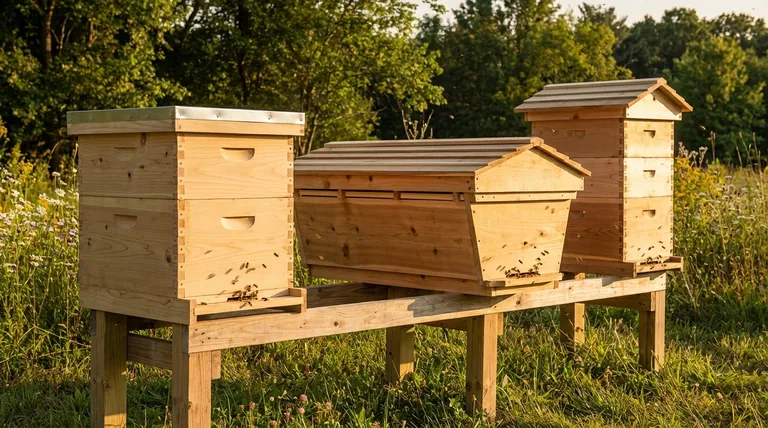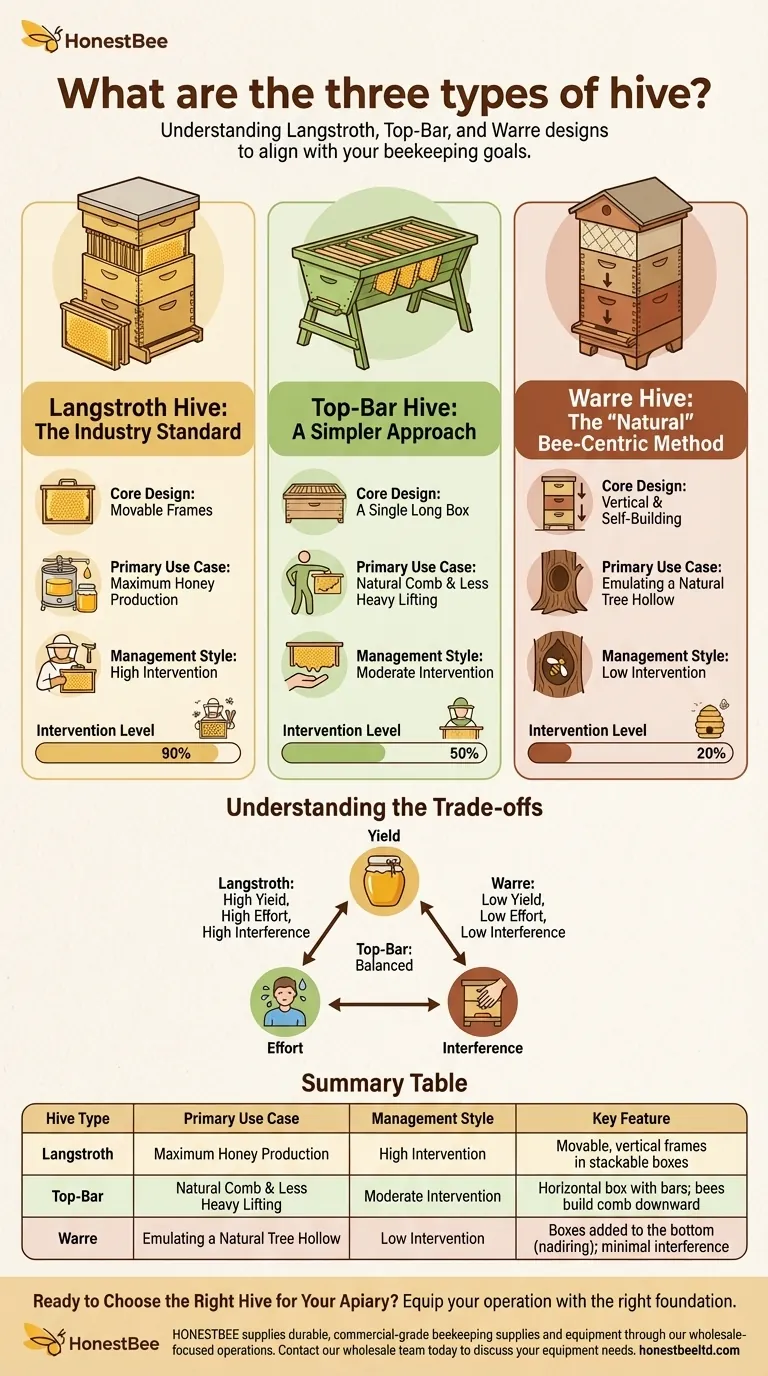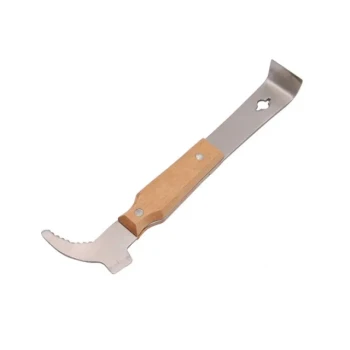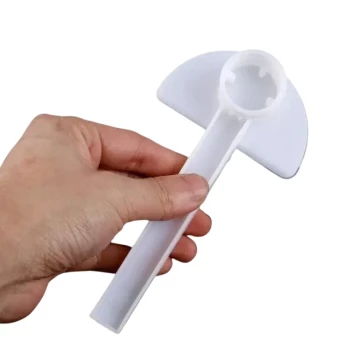While there are many variations, the three foundational hive designs that modern beekeepers choose from are the Langstroth, the Top-Bar, and the Warre hive. Each represents a distinct philosophy of beekeeping, influencing everything from honey yield to the level of interaction required with the colony.
The choice between hive types is not about which box is "best," but about aligning the hive's design with your personal goals as a beekeeper—whether that's maximizing honey production, minimizing heavy lifting, or promoting the most natural bee behavior possible.

The Langstroth Hive: The Industry Standard
The Langstroth is the most recognizable and widely used beehive in the world, especially in North America. Its design, patented in 1852, revolutionized beekeeping.
The Core Design: Movable Frames
The defining feature of the Langstroth is its use of individual, rectangular frames that hang vertically inside a series of stackable boxes. The design is based on the principle of "bee space," a specific gap measurement that prevents bees from sealing the frames together with wax or propolis.
This precise spacing allows each frame to be removed, inspected, and managed individually without destroying the comb.
Primary Use Case: Honey Production
The Langstroth hive is engineered for efficiency and maximum honey harvesting. The uniform, removable frames are perfectly suited for honey extraction using a centrifuge, which spins the honey out while leaving the valuable drawn comb intact for the bees to refill.
Management Style: High Intervention
This design enables and encourages frequent hive inspections. Beekeepers can easily check for disease, assess the queen's laying pattern, and manipulate frames to optimize colony growth and honey storage.
The Top-Bar Hive: A Simpler Approach
The Top-Bar Hive (TBH) offers a simpler, more hands-on approach that differs significantly from the Langstroth's modular boxes.
The Core Design: A Single Long Box
A TBH consists of a single, long horizontal box with wooden bars laid across the top. The bees build their comb down from these bars naturally, creating beautiful, hanging curtains of wax without the constraint of a four-sided frame.
Primary Use Case: Natural Comb & Less Heavy Lifting
Because the hive is horizontal, there is no need to lift heavy boxes (supers) full of honey. Management involves inspecting one bar at a time. This hive is popular among hobbyists who want to harvest both honey and beeswax and prefer a less strenuous management style.
Management Style: Moderate Intervention
Inspections are still possible bar-by-bar, but the fragile, natural comb requires more careful handling than Langstroth frames. Harvesting involves cutting the comb directly from the bar, which is a simpler "crush and strain" method but means the bees must rebuild the comb from scratch.
The Warre Hive: The "Natural" Bee-Centric Method
Developed by French priest Émilien Warre, this hive is designed to mimic the hollow tree logs that bees naturally inhabit. It is often called "the people's hive" for its bee-centric philosophy.
The Core Design: Vertical & Self-Building
Like a Langstroth, the Warre is vertical and uses stacked boxes. However, new boxes are added to the bottom of the hive, a process called "nadiring." This allows the colony to build their comb downward naturally, as they would in the wild.
Primary Use Case: Emulating a Natural Tree Hollow
The entire philosophy of the Warre hive is to let the bees manage themselves with minimal human interference. The small, insulated boxes are meant to retain heat efficiently, and the colony's structure remains largely undisturbed.
Management Style: Low Intervention
The Warre is for the beekeeper who wishes to be more of a bee guardian than a manager. Inspections are rare, and honey is typically harvested only once a year by removing the top box, which contains the oldest comb and cured honey.
Understanding the Trade-offs
Choosing a hive means accepting a set of compromises. No single design is perfect for every situation.
Yield vs. Effort
The Langstroth is built for high honey yields but requires the most physical effort (heavy lifting) and frequent management. The Warre produces the least amount of harvestable honey but demands the least amount of work. The Top-Bar sits in the middle for both yield and effort.
Cost and Accessibility
Langstroth equipment is the industry standard, making it the most affordable and widely available. Top-Bar and Warre hives, while simple in design, are often more expensive to purchase pre-made, though they are popular DIY projects.
Inspection and Health Management
The movable frames of a Langstroth make it the easiest hive for thorough disease inspection and treatment. The fragile, cross-attached comb in a Warre can make inspections nearly impossible without destroying the nest. The Top-Bar offers a good compromise, allowing inspection of individual combs, though they are more delicate than Langstroth frames.
Making the Right Choice for Your Goal
Your primary motivation for keeping bees should be the deciding factor in your choice of hive.
- If your primary focus is maximum honey production and using standard, widely available equipment: The Langstroth hive is the undisputed choice.
- If your primary focus is a more natural approach with less heavy lifting and you value both honey and beeswax: The Top-Bar hive is an excellent, balanced option.
- If your primary focus is on promoting the most natural bee behavior with the absolute minimum of interference: The Warre hive best aligns with your bee-centric goals.
Ultimately, understanding the philosophy behind each hive empowers you to choose the home that best suits both you and your bees.
Summary Table:
| Hive Type | Primary Use Case | Management Style | Key Feature |
|---|---|---|---|
| Langstroth | Maximum Honey Production | High Intervention | Movable, vertical frames in stackable boxes |
| Top-Bar | Natural Comb & Less Heavy Lifting | Moderate Intervention | Horizontal box with bars; bees build comb downward |
| Warre | Emulating a Natural Tree Hollow | Low Intervention | Boxes added to the bottom (nadiring); minimal interference |
Ready to Choose the Right Hive for Your Apiary?
Equip your operation with the right foundation. HONESTBEE supplies durable, commercial-grade beekeeping supplies and equipment to commercial apiaries and distributors through our wholesale-focused operations. We provide the reliable tools you need to succeed, whether you manage Langstroth, Top-Bar, or Warre hives.
Contact our wholesale team today to discuss your equipment needs and streamline your supply chain.
Visual Guide

Related Products
- Langstroth Bee Hives Bee Keeping Box for Beginners Beekeeping
- Langstroth Honey Bee Box Hive Boxes for Different Depths
- Long Langstroth Style Horizontal Top Bar Hive for Wholesale
- HONESTBEE Professional Multi-Functional Hive Tool with Ergonomic Wood Handle
- HONESTBEE Advanced Ergonomic Stainless Steel Hive Tool for Beekeeping
People Also Ask
- What is the best type of bee hive for beginners? Start with the Proven Langstroth Standard
- How does the orientation of the hive sides benefit comb construction? Ensure Straight, Movable Combs for Easier Hive Management
- Should a beginner try a different type of hive? Start with a Langstroth for a solid foundation.
- Why are Langstroth hives recommended for beginners? Unmatched Support & Standardization
- What are the key features of the Langstroth beehive? A Guide to the Standard for Modern Beekeeping



















